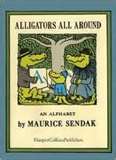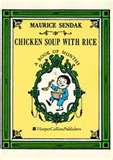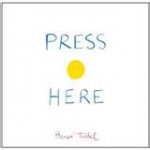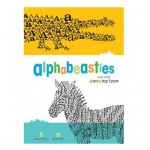Alphabeasties and other Amazing Types
My husband, the illustrious author/illustrator Matt Faulkner, is very intelligent (note his wise choice when picking a spouse). He was also the last kid in his class to learn the alphabet. Matt is very visual, and one of the reasons he had a hard time distinguishing some letters was because they can look so different depending on the font. That’s why Alphabeasties and other Amazing Types by Sharon Werner and Sarah Forss is so terrific. This alphabet book makes animal pictures and alliterative phrases using different typefaces. Uppercase Gs are shown with and without a “beard”, and you’ll see a lowercase g sometimes has a “groovy curl on its head” but sometimes it doesn’t. A gaggle of Gs and gs group together to make a giraffe standing in long blades of grass. The sheep shapes are made of S’s, so the sheep sheared with scissors has a pile of curly S’s at its feet. It’s great to have a book point out that letters can look different in books because of the typeface – “a lowercase a can wear a little hood” or “a lowercase a can be a ball and a stick.” No wonder it earned starred reviews and Parent’s Choice awards. Alphabeasties and other Amazing Types will help all those visual “Picture Smart” learners with letter recognition and the Common Core State Standard of print concepts.
If you have access to computers and printers, let students choose interesting fonts in which to type and print their names. Bring in magazines, newspapers, coupons, etc. for students to cut up and compare letters in different fonts. Students can glue all the a’s on a big A shape, etc., or make alliterative classroom pictures with them by drawing an outline of the animal and letting students glue the corresponding letters onto the shape. An Alphabeasties Amazing Activity Book is available in bookstores along with flashcards. When you’re ready for fun with numbers, check out Werner and Forss’s book Bugs by the Numbers.
For more information about Sharon Werner and Sarah Forss, visit their website at wdw.com
Adventures in Cartooning: how to turn your doodles into comics!
 The Center for Cartoon Studies presents: Adventures in Cartooning (how to turn your doodles into comics!) by James Sturm, Andrew Arnold, and Alexis Frederick-Frost is just what the budding cartoonist needs. A knight, a magical elf, and a candy-loving horse are on a quest to defeat a dragon, but the plot is only a part of this book’s charm. With each step in the adventure, we learn a new technique in cartooning. The little boxes around the pictures are called panels, and changing the background in the panels can make it look like the characters inside the panels are traveling. “In comics,” explains the elf, “words are as important as pictures!” so when the knight wants to let the reader know the castle wall is a thousand miles long, he doesn’t have to draw a reaaallly big panel to contain it all, he describes with his words in a speech bubble. In the end when all seems lost, the characters take fate into their own hands, by drawing and writing a new ending that leads to the next great adventure.
The Center for Cartoon Studies presents: Adventures in Cartooning (how to turn your doodles into comics!) by James Sturm, Andrew Arnold, and Alexis Frederick-Frost is just what the budding cartoonist needs. A knight, a magical elf, and a candy-loving horse are on a quest to defeat a dragon, but the plot is only a part of this book’s charm. With each step in the adventure, we learn a new technique in cartooning. The little boxes around the pictures are called panels, and changing the background in the panels can make it look like the characters inside the panels are traveling. “In comics,” explains the elf, “words are as important as pictures!” so when the knight wants to let the reader know the castle wall is a thousand miles long, he doesn’t have to draw a reaaallly big panel to contain it all, he describes with his words in a speech bubble. In the end when all seems lost, the characters take fate into their own hands, by drawing and writing a new ending that leads to the next great adventure.
Students will love all the techniques they learn in Adventures in Cartooning. You can put those skills to use in a writing activity that shows reading comprehension. Give students a simple story, perhaps a folk tale, or a short story that fits in with some part of your curriculum. After your students read the story, or after you’ve read it to them, let them make a comic strip that will show part of the plot or information they learned. Encourage students to use word balloons and thought balloons (there’s a difference in how they are drawn so readers know if the words are spoken aloud or thought in a character’s head!), panels, lines for movement and action, and backgrounds. Model for students how you might draw a panel to show action. It’s not about perfect drawing, but in finding a way to express your ideas in pictures and in words. In this one lesson, you’ll enhance the Common Core State Standards of Print Concepts, Phonics and Word Recognition, Key Ideas and Details, and Craft and Structure. Even better, your students will be involved in meaningful reading and writing – and enjoying it!
Read MoreWe Will Miss You, Maurice Sendak
 May 8, 2012, the children’s book world lost an honored artist/author/illustrator, Maurice Sendak. Most people remember his book Where the Wild Things Are, but Sendak was by no means a one-hit wonder. He wrote and/or illustrated dozens of children’s books, so today, I’m mentioning a few of my favorites by the master from his 1962 collection, “The Nutshell Library”.
May 8, 2012, the children’s book world lost an honored artist/author/illustrator, Maurice Sendak. Most people remember his book Where the Wild Things Are, but Sendak was by no means a one-hit wonder. He wrote and/or illustrated dozens of children’s books, so today, I’m mentioning a few of my favorites by the master from his 1962 collection, “The Nutshell Library”.
Pierre: a cautionary tale in five chapters and a prologue is a favorite from my childhood. Pierre is so apathetic that he answers “I don’t care,” in any situation, even when a lion asks, “Then I’ll eat you, if I may.” Don’t worry, Pierre is fine when he’s shaken out of the lion by the doctor, and his close call with death has made him realize that he does care after all.
 Alligators All Around is Sendak’s clever, alliterative alphabet book. It is short and snappy enough to keep the interest of the littlest ones, but the humorous art is sly enough for older kids as well:
Alligators All Around is Sendak’s clever, alliterative alphabet book. It is short and snappy enough to keep the interest of the littlest ones, but the humorous art is sly enough for older kids as well:
“A: alligators all around
B: bursting balloons
C: catching colds
D: doing dishes”
It’s a great writing prompt for a whole class or small group activity, writing two word alliterative phrases for each letter of the alphabet, choosing an A animal as the character to tie all the letters together.
 “Whoopy once
“Whoopy once
whoopy twice
whoopy chicken soup
with rice.”
I adore Chicken Soup with Rice: a book of months. I visited a first grade classroom where the teacher had a poster for each month with the verse by Sendak for children to illustrate. Every month has the repetition of (something) once, (something) twice, (something) chicken soup with rice, so even emerging readers can chime in with confidence.
The “Nutshell Library” books were set to music by Carole King. You can find the songs on her cd “Really Rosie”, and you can find the animated television special made in 1975 on VHS if you roll old school. I love how kids instantly spot the similarities of Pierre and the boy on the cover of Chicken Soup with Rice to Max from Where the Wild Things Are. Share some Sendak books with your kids and talk about the similarities and differences in the art and in the plots. Play the music from “Really Rosie” and let your students sing the “Nutshell Library” books so your students can be, to paraphrase Alligators All Around, “S: singing Sendak!”
Read More“Press Here” for fun!
 My dear friend’s daughter, Nora, turned one this month, and as a librarian, writer, and ardent-bordering-on-obsessive fan of children’s literature, I felt it my duty to include a book in her birthday bag o’ swag. Which book to choose? Press Here by Herve Tullet. Deceptively simple, it consists of dots and directions on what to do with them. Press the yellow dot and turn the page. Now there are two dots. Press the yellow dot again, and on the next page, now there are three dots. Tilt the book to the left, and on the next page, the dots seem to have slid to the left edge. Clap your hands to make the dots big, bigger, bigger. It is what electronic books wish they could be: it is interactive, delightful, and requires no batteries.
My dear friend’s daughter, Nora, turned one this month, and as a librarian, writer, and ardent-bordering-on-obsessive fan of children’s literature, I felt it my duty to include a book in her birthday bag o’ swag. Which book to choose? Press Here by Herve Tullet. Deceptively simple, it consists of dots and directions on what to do with them. Press the yellow dot and turn the page. Now there are two dots. Press the yellow dot again, and on the next page, now there are three dots. Tilt the book to the left, and on the next page, the dots seem to have slid to the left edge. Clap your hands to make the dots big, bigger, bigger. It is what electronic books wish they could be: it is interactive, delightful, and requires no batteries.
Considering that I had to pry Press Here from the hands of my 12- and 10-year-old children to put it in Nora’s gift bag, I can honestly say it’s not just for the littlest ones. My kids are no strangers to electronic games and they logically understand the way paper books work, but both of them followed all the instructions on the pages, like shaking the book to make the dots “move”. For toddlers, this book is magical. For kids who are building their reading skills, the simple text is engaging enough to read again, again, again. Press Here and see what happens!
Read More







